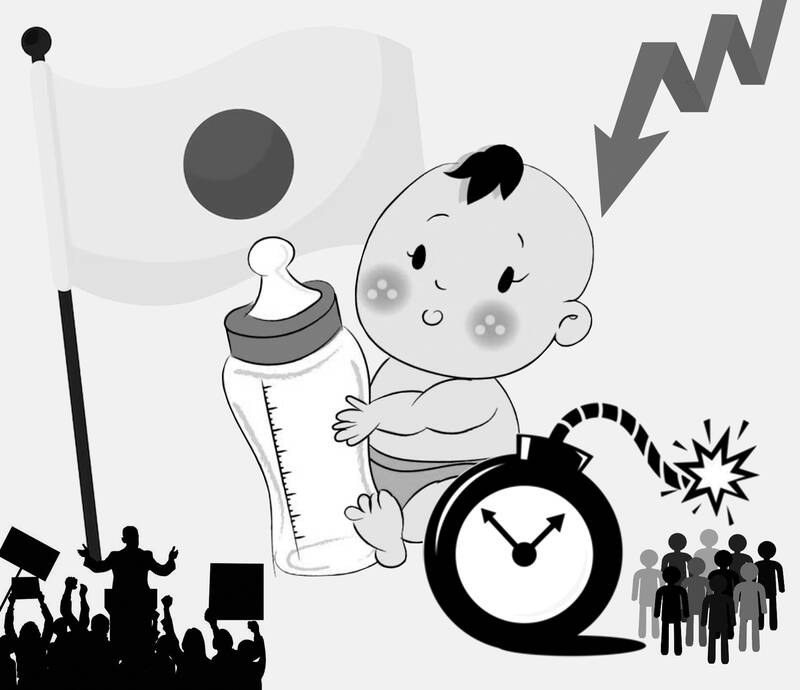An increase in births to non-Japanese comes as politicians keep dodging the choice between economic decline and a more diverse population
By Justin McCurry / The Guardian, TOKYO
This week brought encouraging news for Japan’s long battle to defuse its demographic time bomb: Last year, the number of babies born to one sector of the population rose to a record of more than 22,000 — that is about 3,000 more than the previous year and a 50 percent increase on a decade ago.
But none of the women who answered calls — invariably issued by conservative male politicians — to have more children were Japanese.
Despite the happy backdrop, the cries of babies born to women from China, Brazil, the Philippines and Vietnam reverberating around maternity wards was a reminder of the failure of successive governments to persuade Japanese couples to have bigger families.

Illustration: Constance Chou
Births among Japanese parents stood at 686,000 babies, 41,000 fewer than in 2023, according to the data, released in the same week as figures showing that Japan’s foreign population is edging towards 4 million (3.2 percent) — a share of the 124 million population that would have been unimaginable a decade ago.
The surge in migration has not happened by accident, and should not have been unexpected. It has been seven years since then-Japanese prime minister Shinzo Abe — hardly a liberal — recognized the need to accept more low-skilled workers to address labor shortages.
Non-Japanese faces are no longer a novelty in towns and cities, and, increasingly, in depopulated rural regions. Immigrants work in convenience stores, restaurants and factories, on building sites, and in agriculture and fishing.
Previous descriptions of Japan as a modern-day sakoku nation of self-imposed isolation, whose leaders refuse to lower the drawbridge to all but a few foreign workers, is clearly out of date, but the national debate over migration feels all too familiar, starting with the response to elections in which Sanseito, a minor party of the right, dramatically strengthened its presence in the upper house after vowing to put “Japanese first.”
Sanseito now has 15 seats in a 248-seat chamber, in addition to three in the more powerful lower house. Its rise could — as some commentators suggested — be short-lived as voters, having registered their dissent, return to more mainstream parties.
A snap general election notwithstanding, Sanseito and its leader, Sohei Kamiya, would have to wait until 2028 to build on the gains it made this summer, but it has already succeeded in setting the tone of the debate on immigration.
All of the major parties, including those on the center-left, have voiced concern over foreign workers, while the governing Liberal Democratic Party (LDP) has vowed to bring illegal immigration down to zero and ensure that guest workers do more to integrate.
During the LDP’s contest to elect a new leader, the winner, Sanae Takaichi, opened her campaign with a broadside against badly behaved foreign tourists, claiming without evidence that she had personally witnessed a visitor assault one of the sacred deer in Nara, where she is a lawmaker.
Other politicians have tapped into claims that foreign migrants are taking jobs from Japanese workers and are more likely to commit crimes — neither of which are supported by evidence.
The debate occasionally spills over into xenophobia.
In Kawaguchi, near Tokyo, Kurdish residents are the targets of hate speech and misinformation. Authorities in four regional cities were forced to clarify that a now-canceled friendship initiative with African nations would not lead to an influx of workers from Mozambique, Nigeria, Ghana and Tanzania.
At a ski resort in Hokkaido, locals are protesting against plans to build lodgings for more than 1,000 seasonal workers, many of whom are foreign, drafted in to work in tourism and construction.
There are signs, though, that economic necessity would eclipse the political rhetoric and migration would continue to accelerate at a pace that could see foreigners comprise more than 10 percent of the population in 15 years — three decades sooner than previously forecast.
That would please business leaders polled by the Nikkei business paper last month, almost all of whom said migrant workers were the vital link in a supply chain that would strain to breaking point without them.
While Japan’s employers have answered the migrant worker question in the affirmative, the choice between economic decline and a more diverse population is one the nation’s politicians continue to dodge.

AloJapan.com